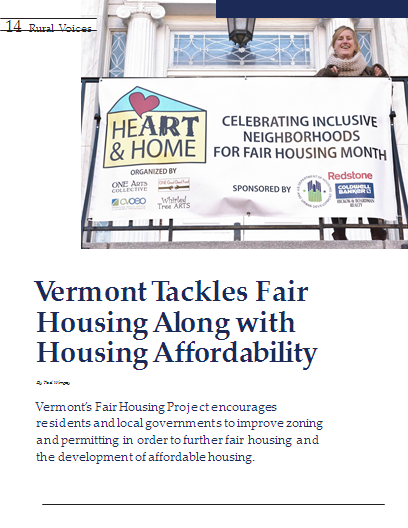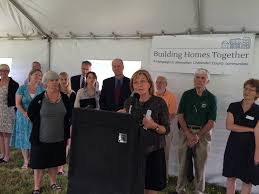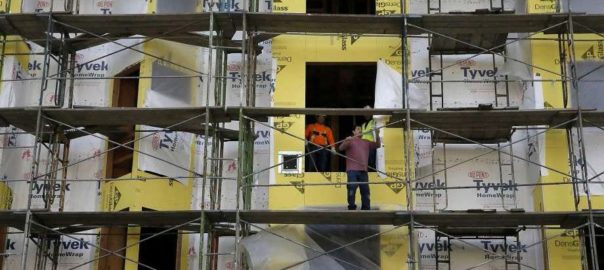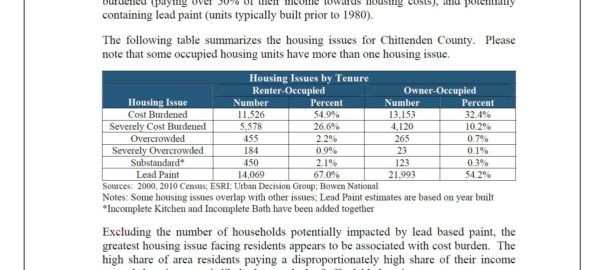
FHP organized event in front of Burlington, VT City Hall Continue reading WORKING TOWARD ACCESS FOR ALL – Fifty Years of the Fair Housing Act: a Vermont Perspective

FHP organized event in front of Burlington, VT City Hall Continue reading WORKING TOWARD ACCESS FOR ALL – Fifty Years of the Fair Housing Act: a Vermont Perspective
By Briana Bocelli, a freelance writer for True North Reports. 12/6/17

“The House and Senate tax bills could be detrimental to an already struggling affordable housing situation in Vermont, according to estimates released by the Vermont Affordable Housing Coalition.”
 Working in a non-profit organization, and often working most directly on public policy and advocacy issues with people in other non-profit or governmental entities, I can easily lose sight of some aspects of the universe of for-profit businesses. I recently started thinking more about how much overlap and shared common interests that my work as an advocate for affordable and inclusive housing has with at least some private for-profit housing developers. We both are often striving for zoning by-laws that permit a higher density of homes, narrower setback requirements, more flexible parking requirements and simpler-more predictable permitting processes among a myriad of other related things.
Working in a non-profit organization, and often working most directly on public policy and advocacy issues with people in other non-profit or governmental entities, I can easily lose sight of some aspects of the universe of for-profit businesses. I recently started thinking more about how much overlap and shared common interests that my work as an advocate for affordable and inclusive housing has with at least some private for-profit housing developers. We both are often striving for zoning by-laws that permit a higher density of homes, narrower setback requirements, more flexible parking requirements and simpler-more predictable permitting processes among a myriad of other related things.
My primary aim is to create more homes at rental and sale prices that are more affordable to more people in a state with very high housing costs and housing shortages in many places. I know that a more or less planned increasing supply of homes especially in combination with various public subsidies can generate at least some housing that is affordable to people on the lower ends of the income scale. I also know that because of the fact that more people in certain fair housing protected classes tend to have lower incomes and that developing more affordable and accessible homes will increase housing opportunities for people in protected classes. The flip side is that shortages of housing supply, overdevelopment of high end housing on large lot sizes, and long uncertain and unnecessarily daunting and expensive permitting processes will tend to increase the price of homes and that tends to disparately exclude— whether purposely or not— people in protected classes such as many minorities, people with disabilities, and others. My goal is creating more inclusive and less expensive homes and communities, and not creating more exclusive and more expensive homes and communities.
Achieving more of the goals of inclusivity will create conditions that are beneficial to large sectors of our towns and cities—including businesses that need more workers, more shoppers and more consumers of services. Governmental entities will be in better shape also with a broader tax base to help maintain needed services.
To get to a state of increased inclusion and affordability will require some willingness to change some bylaws that have been around for a long time and if they ever had a good purpose do not do so now in our current society and economy. It is in the work of achieving some of these changes that I have come to realize that advocates of fair, affordable and safe homes have good opportunities to collaborate with private developers.
To this end our Fair Housing Project has pulled together some private developers, currently mostly in the Chittenden County, Vermont area, to join forces with us to work on some of those things we agree on and to perhaps mitigate some of the areas of disagreement that we will no doubt have.
Getting stuck in our own limited world view does not help us make real progress in our communities. We can break out of that mode.
CHAMPLAIN VALLEY OFFICE OF ECONOMIC OPPORTUNITY (CVOEO) RELEASES STUDY SHOWING “THE DEMOGRAPHIC AND ECONOMIC CONTRIBUTIONS OF NEW AMERICANS TO CHITTENDEN COUNTY, VERMONT”
From CVOEO Press Release, June 12, 2017

New Americans contribute significantly to Chittenden County’s housing values, GDP, and job market according to a new report released by the Champlain Valley Office of Economic Opportunity (CVOEO). The release of this report will be announced by Ali Dieng, CVOEO board member, with Jan Demers, CVOEO Executive Director, and Alex Duchac, author of the study, will both speak.
Produced for CVOEO by Alex Duchac, this report will give the first detailed look at how immigrants impact Vermont’s largest county. The report documents the wide range of benefits provided by New Americans in Chittenden County. Among the significant discoveries included in the report are that, since 2009, New Americans have increased home values by $25M, they have added over $712M to the GDP of Chittenden County, and they have saved more than 270 Vermont manufacturing jobs.
PUBLIC ANNOUNCEMENT EVENT: WHEN: 3:00 pm, June 15, 2017 WHERE:Flynn Center for the Performing Arts(just prior to Parent University Graduation at 3:30) CONTACT: Joan White, Development Director CVOEO. joanwhite@cvoeo.org; 802-862-2771 ext.744

– San Francisco Chronicle http://www.sfchronicle.com/opinion/openforum/article/Reform-land-use-promote-shared-growth-of-new-9283703.php
By Jason Furman | September 25, 2016 | Updated: September 25, 2016 8:34pm
 Photo: Michael Macor, The Chronicle
Photo: Michael Macor, The Chronicle
When certain government policies — like minimum lot sizes, off-street parking requirements, height limits, prohibitions on multifamily housing, or unnecessarily lengthy permitting processes — restrict the supply of housing, fewer units are available and the price rises.
It is no secret that cities like San Francisco, New York and Washington, D.C., face challenges in the availability and cost of housing. But policymakers and economists have increasingly recognized both the role that certain inappropriate land use restrictions play in raising housing costs — not just in major cities but across the country — and the opportunity for modernizing these regulations to promote shared growth.
Basic economic theory predicts that when the supply of a good is constrained, its price rises and the quantity available falls. In this respect, the market for housing is no different: When certain government policies — like minimum lot sizes, off-street parking requirements, height limits, prohibitions on multifamily housing, or unnecessarily lengthy permitting processes — restrict the supply of housing, fewer units are available and the price rises. On the other hand, more efficient policies can promote availability and affordability of housing, regional economic development, transportation options and socioeconomic diversity.
Research suggests that local barriers have become more restrictive in recent decades. One way to measure this is comparing the sale price of houses with construction costs. This gap typically reflects the cost of buying land — which increases with tighter land use restrictions. Indeed, the gap has increased in the past two decades: House prices from 2010 to 2013 were 56 percent higher than construction costs, a 23 percentage-point crease over the average gap during the 1990s.
Of course, many land use regulations can have benefits for communities. Environmental reasons in some localities may make it appropriate to limit high-density or multiuse development. Similarly, health and safety concerns — such as an area’s air traffic patterns, viability of its water supply, or its geologic stability — may merit height and lot size restrictions.
But in other cases, barriers to housing development can allow a small number of individuals to enjoy the benefits of living in a community while excluding many others, limiting diversity and economic mobility.
This upward pressure on house prices may also undermine the market forces that typically determine patterns of housing construction, leading to mismatches between household needs and available housing.
Improving land use policies can also create benefits for the U.S. economy as a whole. High- productivity cities offer higher-income jobs than low-productivity cities and often attract workers who move from other cities, naturally bringing more resources to productive areas of the country. But when unnecessary barriers restrict the supply of housing and costs increase, then workers — particularly lower-income workers who would benefit the most — are less able to move.
All told, this means slower economic growth: Some researchers have estimated that GDP could have been almost 10 percent higher in 2009 if workers and capital freely moved so that the distribution of wages across cities was the same as in 1964.
On the other hand, smarter land use and housing policy can promote both growth and equity. While most land use policies are appropriately made at the state and local level, the federal government can also play a role in encouraging smart land use regulations. Today, the Obama administration is releasing a new toolkit at http://bit.ly/2d4dVAc that highlights best practices that localities have employed — including streamlining permitting processes, eliminating off-street parking requirements, reducing minimum lot sizes, and enacting high-density and multifamily zoning policies — to reduce overly burdensome land use restrictions and promote mobility and economic growth.
Reforming land use policies can have important benefits for local residents and the nation as a whole, not only raising economic growth, but ensuring that its benefits are widely shared among all Americans.
Jason Furman is the chairman of the White House Council of Economic Advisers.
Okay dear readers, this is a wonky article but for those of you interested in HUD’s Affirmatively Furthering Fair Housing rule it is a good read. (Ted Wimpey)
“For most of the Fair Housing Act’s history, its requirement to “Affirmatively Further Fair Housing” has been largely dormant. With the advent of the new AFFH rules in July 2015, however, there is some promise that this provision might be taken more seriously.”
http://tinyurl.com/AFFH-rule-FHA-DetailDevils Link to ROOFLINES, the Shelterforce Blog,

South Burlington, VT – Dozens of Chittenden County leaders in the fields of housing, business, local and state government, and social services announced this morning a new campaign to increase the production of housing and setting a target of 3,500 new homes created in the next five years.
The new coalition, called Building Homes Together, was formed by the Champlain Housing Trust, Chittenden County Regional Planning Commission and Housing Vermont and released an initial list of nearly 100 community leaders supporting the effort.
“Working together we will accomplish this goal,” said Brenda Torpy, CEO of Champlain Housing Trust. “For the sake of our communities, our workers and local economy, we will educate and advocate together for more housing.”
“The housing shortage in Chittenden County has been well noted with unhealthy vacancy rates and high rents,” added Charlie Baker, Executive Director of the Chittenden County Regional Planning Commission. “Employers can’t find workers, and workers themselves spend more time in commutes and with a higher percentage of their paychecks on housing costs.”
Twenty percent of the 3,500 goal are targeted to be developed by nonprofit housing organizations. The remainder by private developers.
“This step-up in production will not just provide new homes and infrastructure for communities, it’ll be a boost to the economy and contribute to the tax base. Building homes together is a big win for all of us in Chittenden County,” said Nancy Owens, President of Housing Vermont.
The campaign will provide up-to-date data to the community on the need for and benefits of new housing, build cross-sector and public support for housing development, increasing access to capital, and supporting municipalities.
Individuals, businesses or organizations that wish to sign on and participate in the campaign are encouraged to by sending an email to Chris Donnelly at Champlain Housing Trust (chris@champlainhousingtrust.org). For more information, visit www.getahome.org/news/building-homes-together

I am sharing here in full an article about a U.S. Ninth Circuit Court of Appeals decision with significant fair housing and Affirmatively Furthering Fair Housing import for planning, zoning and permitting of residential housing development that was published April 28, 2016 in the legal issue blog site, “Manatt.” Especially check out the three basic “Practice Pointers” at the end of the article for the main take away.
— https://www.manatt.com/real-estate-and-land-use/Landmark-Discrimination-Case-Fair-Housing-Act-Thwarts.aspx —-
—————————————————-
Real Estate and Land Use
Apr 28, 2016
Landmark Discrimination Case: Fair Housing Act Thwarts NIMBYs
Avenue 6E Investments, LLC v. City of Yuma (March 25, 2016)
Author: Michael M. Berger
Why It Matters: The Ninth Circuit Court of Appeals reversed a decision in favor of the City of Yuma, Arizona, and concluded instead that there was sufficient evidence to present to a jury that the City had rejected the developer’s application for an increase in zoning density for reasons of barely disguised animus toward the expected residents of the new development. The Court held that issues of disparate treatment and disparate impact under both the 14th Amendment’s Equal Protection Clause and the federal Fair Housing Act needed to be tried.
Facts: The plaintiffs/developers acquired 42 acres of undeveloped land with the intent of building a “moderately priced” housing project. They are known in the area as a developer of Hispanic neighborhoods. Although the General Plan allowed for homes on either 6,000- or 8,000-square-foot lots, a prior owner had it zoned for 8,000-square-foot lots. Unfortunately, the economy would no longer support lots of that size and the developers sought a rezoning to the smaller size which in turn would allow increased density. The City had done some studies, concluding that its population was racially divided, with most of the low-to-moderate-income housing in the areas populated by Hispanics. These developers wanted to develop their housing on the border of a predominantly white area.
The City’s General Plan acknowledged that racial segregation is wrong and that large-lot zoning raises housing costs and impairs the ability of the City to provide housing for moderate-income buyers. The Planning Commission approved the rezoning to smaller lots and recommended that the City Council do so as well. The City Council, however, was besieged with NIMBY complaints and thinly veiled anti-Hispanic charges, complaining that these particular developers were known to “cater to” the people responsible for the vast majority of major crimes.
Two other facts had some import. First, there were similarly priced and modelled homes available elsewhere in Yuma, a fact that the City thought absolved it of any claims of disparate impact. Second, a fact that proved difficult for the City to impress on the Court was that, in the preceding three years, this was the only rezoning request that had been rejected out of 76 applications.
The developers filed suit under the federal Civil Rights Act, 42 U.S.C. § 1983, for violation of the Equal Protection guarantee, as well as for disparate impact and treatment under the Fair Housing Act. The trial court entered summary judgment for the City on the sole ground that the adequate supply of similar housing elsewhere in the City automatically foreclosed any finding of disparate impact.
The Decision: The Court of Appeals reversed. When the opinion began with a paean to the Fair Housing Act and the way it “strikes at the heart of the persistent racism that so deeply troubles our Nation,” something that the provision of more affordable housing can help to cure, it was apparent that the conclusion was foregone: judgment reversed.
The Court of Appeals was unable to disregard the bright light of the fact that out of 76 applications, the only time the City had denied a zone change in the past three years was this one. There could be no explanation for the denial other than racism, particularly in light of some of the communications made by neighbors to the City Council about the presumed criminal proclivities of the anticipated residents of the new development. Nor would the Court have anything to do with the trial court’s idea that the presence of similar developments elsewhere in Yuma obviated the problem. Indeed, it merely emphasized the fact that the City was racially divided and at least some of its residents wanted things to remain that way.
There appeared to be no principled opposition to the requested zone change. As the Court of Appeals put it, the record was replete with “code words” and “veiled references” for the Hispanic influx that the neighbors anticipated, turning the development into a “low-cost, high-crime neighborhood.” The case had no chance on appeal.
Practice Pointers: